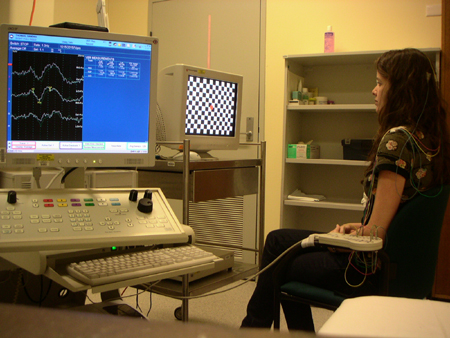Visual Evoked Potential (VEP)
In adults and cooperative older children, visual acuity (the ability to see fine detail and patterns) is measured using a letter chart. For those who are unable to read the letter chart, the visual evoked potential (VEP) can be used. It measures acuity by assessing the response of the brain to alternating black and white stripes or checks. This acuity test is most helpful for testing youngsters for whom other vision tests, like the preferential looking test, give ambiguous or incomplete information about visual acuity.
To do the test, three small metal discs are placed on the child's head. They are held in place by paste (similar to toothpaste) and a band wrapped around the head. The discs are connected by wires to a computer.
The child is then positioned in front of a TV screen displaying alternating black and white stripes or checks that progressively get smaller. As the child views the stripes, a signal is relayed from the eyes to the brain (the visual cortex). This signal is detected by the electrodes. The test is designed to find the smallest stripes or checks that reliably produce a response.
Often the vision of each eye is tested separately; a patch is used to cover the non-tested eye. The test typically takes less than an hour, depending on the child's ability to cooperate.
In adults and cooperative older children, visual acuity (the ability to see fine detail and patterns) is measured using a letter chart. For those who are unable to read the letter chart, the visual evoked potential (VEP) can be used. It measures acuity by assessing the response of the brain to alternating black and white stripes or checks. This acuity test is most helpful for testing youngsters for whom other vision tests, like the preferential looking test, give ambiguous or incomplete information about visual acuity.
To do the test, three small metal discs are placed on the child's head. They are held in place by paste (similar to toothpaste) and a band wrapped around the head. The discs are connected by wires to a computer.
The child is then positioned in front of a TV screen displaying alternating black and white stripes or checks that progressively get smaller. As the child views the stripes, a signal is relayed from the eyes to the brain (the visual cortex). This signal is detected by the electrodes. The test is designed to find the smallest stripes or checks that reliably produce a response.
Often the vision of each eye is tested separately; a patch is used to cover the non-tested eye. The test typically takes less than an hour, depending on the child's ability to cooperate.
Image source: http://www.myvmc.com/investigations/visual-evoked-potential-vep/
A subject completing the Visual Evoked Potential test
A subject completing the Visual Evoked Potential test
